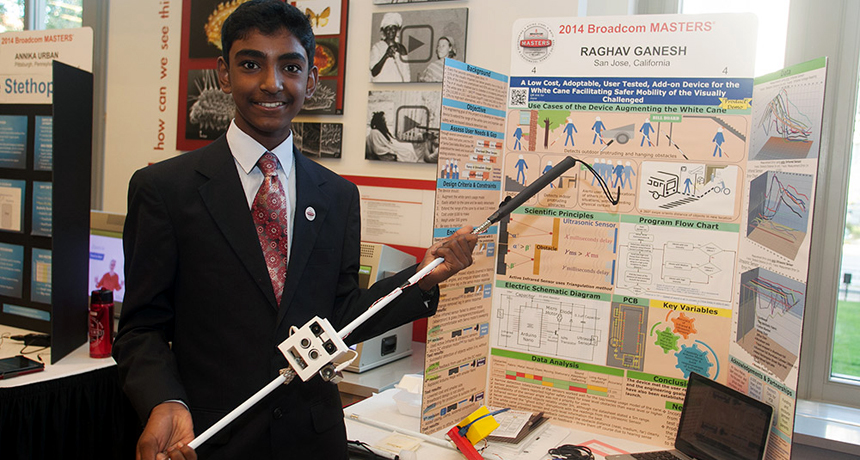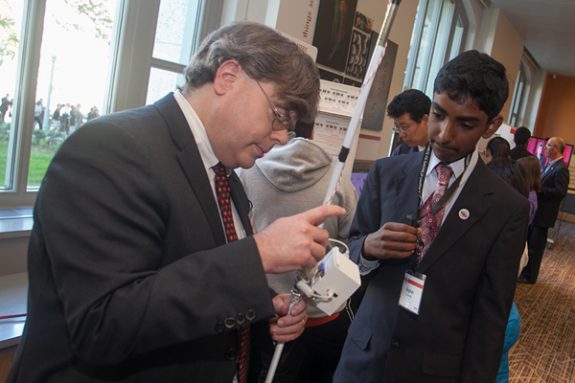A cane that can ‘see’
A nifty device clipped onto a blind person’s cane can detect objects in a person’s path,to help navigate trip hazards

Raghav Ganesh, who lives in San Jose, Calif., invented a sensor package (white box attached to cane) that alerts blind people when knee-high obstacles are in their path.
P. Thornton/ SSP
By Sid Perkins
Safely navigating from point A to point B can be a particularly difficult challenge for people who are blind. Even when sweeping a long cane back and forth across their path as they’re walking, blind people easily can miss objects that might trigger a tumble. Now, a young inventor has designed an electronic device to notify people of such obstacles.
Among the biggest trip hazards for blind people: objects between 50 centimeters (about 20 inches) to 1 meter (about 39 inches) above the floor. Such knee-high to waist-high objects include coffee tables, bed frames and other such furniture with overhanging edges, notes Raghav Ganesh. A 12-year-old from San Jose, Calif., he attends Joaquin Miller Middle School.
To prevent falls, bruises and maybe worse, Raghav decided to add electronic “eyes” to the red-and-white cane that many blind people use. To identify what’s ahead, cane users typically tap the ground and sweep their stick back and forth. But Raghav’s cane lets people sense objects well beyond a walking stick’s reach. A small computer acts as the device’s brain. It processes information gathered by sensors. Then, it relays signals to a small motor on the cane. The motor vibrates as soon as the cane’s electronic eyes detect a potential obstacle.

Each sensor is about half the size of a postage stamp. Together, the cane’s electronic eyes and brain weigh about 200 grams (7 ounces). They fit in a small box about twice the size of a deck of cards. The small motor that vibrates is about the size of a coin and the weight of a similar-sized kitchen magnet. It fits on the cane’s handle, right where the user grips the cane.
The sensors have a very narrow field of view. That means they can only see things directly ahead — similar to looking through a soda straw. But that’s an advantage for this application, Raghav says. It means the cane’s sensors will not be confused by objects that aren’t directly in someone’s path. As the user sweeps the cane back and forth, the cane vibrates to warn about knee-high objects as far as 3 meters (about 10 feet) ahead. When the path is clear, the vibrations stop.
Raghav’s invention cost about $55 to make, so it’s very affordable. It’s also easy to use. The student recruited about 20 people from the Santa Clara Valley Blind Center to test his device. The non-profit organization provides services to blind people in Raghav’s hometown. Some volunteers who tried the enhanced cane were almost or completely blind. Still, they learned to use the seeing-eye cane in as little as 10 minutes, Raghav says.
The seventh grader presented his test results to the public this week in Washington, D.C., at the finals of the fourth annual Broadcom MASTERS (Math, Applied Science, Technology and Engineering for Rising Stars) competition. This program for middle school students is run by Society for Science & the Public (SSP), publisher of Science News for Students . It is sponsored by Broadcom Foundation, a nonprofit public benefit corporation funded by Broadcom Corporation.Raghav hopes to improve his cane’s current design. He would like it to be more compact and efficient. Improvements might also make the clip-on sensor package lighter and less expensive.
Soon, Raghav will begin using funds from a small grant provided by Youth Service America to manufacture his invention. It’s clip-on sensor package will then be donated to people requiring the center’s services. Eventually, the pre-teen intends to file for an open patent on his design. That will allow other non-profit organizations that serve the blind to make and distribute these devices to people in need.
Power words
engineering The field of research that uses math and science to solve practical problems.
frequency The number of times a specified periodic phenomenon occurs within a specified time interval. (In physics) The number of wavelengths that occurs over a particular interval of time.
infrared light A type of electromagnetic radiation invisible to the human eye. The name incorporates a Latin term and means “below red.” Infrared light has wavelengths longer than those visible to humans. Other invisible wavelengths include X rays, radio waves and microwaves. It tends to record a hit signature of an object or environment.
patent A legal document that gives inventors control over how their inventions — including devices, machines, materials, processes and substances — are made, used and sold for a set period of time. Currently, this is 20 years from the date you first file for the patent. The U.S. government only grants patents to inventions shown to be unique.
prototype A first or early model of some device, system or product that still needs to be perfected.
sensor A device that picks up information on physical or chemical conditions — such as temperature, barometric pressure, salinity, humidity, pH, light intensity or radiation — and stores or broadcasts that information. Scientists and engineers often rely on sensors to inform them of conditions that may change over time or that exist far from where a researcher can measure them directly.
ultrasound Sounds at frequencies above the range that can be detected by the human ear. (adj. ultrasonic)
wavelength The distance between one peak and the next in a series of waves, or the distance between one trough and the next. Visible light — which, like all electromagnetic radiation, travels in waves — includes wavelengths between about 380 nanometers (violet) and about 740 nanometers (red). Radiation with wavelengths shorter than visible light includes gamma rays, X-rays and ultraviolet light. Longer-wavelength radiation includes infrared light, microwaves and radio waves.







